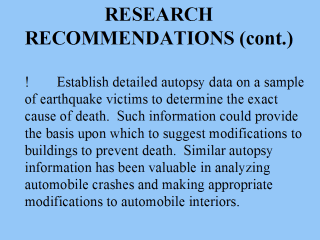| front |1 |2 |3 |4 |5 |6 |7 |8 |9 |10 |11 |12 |13 |14 |15 |16 |17 |18 |19 |20 |21 |22 |23 |24 |25 |26 |27 |28 |29 |30 |31 |32 |review |
 |
! Evaluate the
efficacy of search-and-rescue efforts and of medical care rendered following
earthquakes. A careful investigation of the organizational barriers to rapid
response is required to improve the ability of rescue and field medical
teams to respond rapidly enough to save the lives of the most seriously
injured disaster victims. Studies of the epidemiology of injured survivors
may also help to identify the best way to dismantle a collapsed building
(135) and to conduct rescue without doing more damage to those trapped. ! Study immediate medical needs of people entrapped in buildings following earthquakes. Such studies could help identify effective interventions to prevent or to manage casualties (e.g. treatment of crush syndrome) as well as to minimize disability (e.g., by reducing the incidence of wound infections and postoperative complications in the field). ! Determine whether knowledge of injury patterns following an earthquake can be used to suggest design changes in the structural and nonstructural components of a building. |